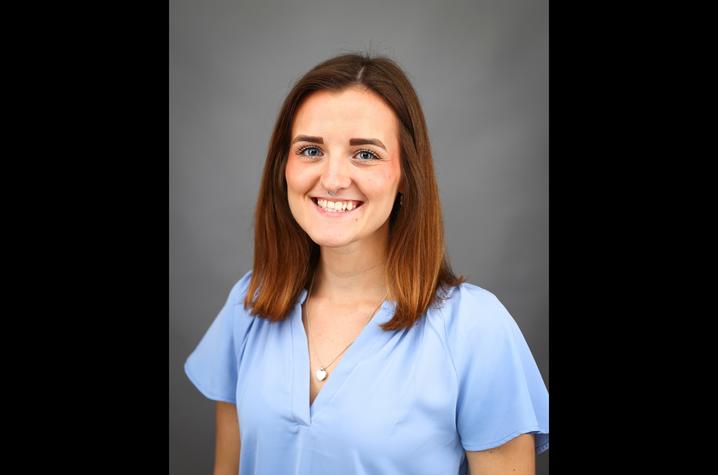Public Health student uses wristbands to study East Palestine chemical exposure

LEXINGTON, Ky. (Dec. 19, 2024) — Sydney Shafer, a doctorate student earning a Ph.D. at the University of Kentucky College of Public Health (CPH), is on a mission to better understand air quality and chemical exposures in East Palestine, Ohio, following the derailment of a freight train carrying hazardous materials in early 2023.
Shafer has partnered with Erin Haynes, Dr.P.H., the Kurt W. Deuschle Professor of Preventive Medicine and Environmental Health at CPH, and Heather Stapleton, Ph.D., from Duke University, to examine East Palestine residents’ personal exposure to semi-volatile organic compounds (SVOCs) using silicone wristbands. This is part of Haynes’ ongoing research funded by the National Institute of Environmental Health Sciences (NIEHS).
The team’s innovative research used silicone wristbands that capture chemicals in the ambient environment. The wristbands, developed and validated by Stapleton’s lab at Duke University, passively absorb chemicals from the environment, allowing researchers to estimate individual exposure levels.
“Silicone wristbands are very effective as personal sampling devices because they’re noninvasive, inexpensive, and have the ability to capture exposure measurements for over 100 SVOCs,” Shafer explained.
The road to East Palestine
Originally from Stevensville, Michigan, Shafer earned her bachelor’s degree in public health at Wayne State University in Detroit, and her master’s degree in public health (MPH) with a concentration in epidemiology from CPH in 2022. Her journey into Ph.D. research happened through her connections within CPH.
“Before I even left UK with my MPH, I had thought about applying for a Ph.D.,” Shafer said. “Part of the reason UK’s program specifically stood out to me is the fact that it’s a dual program for epidemiology and biostatistics.”
Shafer’s interest in environmental health led her to Dr. Haynes’ team.
“I was very excited to join her team and analyze this data,” Shafer said.
Key findings and health implications
As part of the study, 80 participants from East Palestine wore the wristbands for one week in July 2023. The researchers were specifically interested in data on chemicals such as dioxins, furans, polycyclic aromatic hydrocarbons (PAHs), phthalates and pesticides.
Encouragingly, no dioxins or furans were detected, which Shafer described as “great news.” PAHs, on the other hand, were detected.
The Agency for Toxic Substances and Disease Registry describes PAHs as “a group of chemicals that are formed during the incomplete burning of coal, oil, gas, wood, garbage or other organic substances, such as tobacco and charbroiled meat.” The International Agency for Research on Cancer and the Environmental Protection Agency have determined that certain PAHs are “probably carcinogenic” to humans.
Shafer and Haynes suspect that the presence of PAHs in East Palestine is due to truck traffic potentially related to debris removal after the derailment and the Canadian wildfires that were active during the sampling period.
“Most of these chemicals measured on the wristbands are not directly related to the train derailment, but the results can be helpful for residents in making decisions about product use and exposure,” said Haynes. Chemicals included flame retardants, phthalates, pesticides, PCBs, nicotine and chemicals found in personal care products.
The study also identified certain behaviors that correlated with higher levels of chemical exposure.
“We found that on average, male participants had two more PAHs detected than did women, and those working with heavy machinery had four more PAHs detected than those who did not,” Shafer said.
Smokers and those exposed to secondhand smoke also had higher levels of detected nicotine, they noted.
Recognizing the importance of community engagement, the researchers sent each participant a letter detailing their personal exposure levels.
Shafer emphasized the importance of communicating the study’s findings in a way that would benefit the participants directly.
“We wanted participants to have a clear understanding of what chemicals, if any, were detected in their environment,” Shafer said. “Our goal was to empower them with information to inform them of the many chemicals they are exposed to nearly every day.”
This commitment to bridging research and community impact reflects the broader value of her work.
Shafer’s experience working on this project was both a significant learning opportunity and a rewarding challenge. Through her collaboration with Haynes, Shafer was able to apply her training in epidemiology and biostatistics to real-world data analysis, contributing to important findings about chemical exposures in East Palestine. Through this work, she found even more passion for public health and for working with others to tackle big challenges.
Research reported in this publication was supported by the National Institute of Environmental Health Sciences of the National Institutes of Health under Award Number R21ES036036. The content is solely the responsibility of the authors and does not necessarily represent the official views of the National Institutes of Health.
As the state’s flagship, land-grant institution, the University of Kentucky exists to advance the Commonwealth. We do that by preparing the next generation of leaders — placing students at the heart of everything we do — and transforming the lives of Kentuckians through education, research and creative work, service and health care. We pride ourselves on being a catalyst for breakthroughs and a force for healing, a place where ingenuity unfolds. It's all made possible by our people — visionaries, disruptors and pioneers — who make up 200 academic programs, a $476.5 million research and development enterprise and a world-class medical center, all on one campus.




